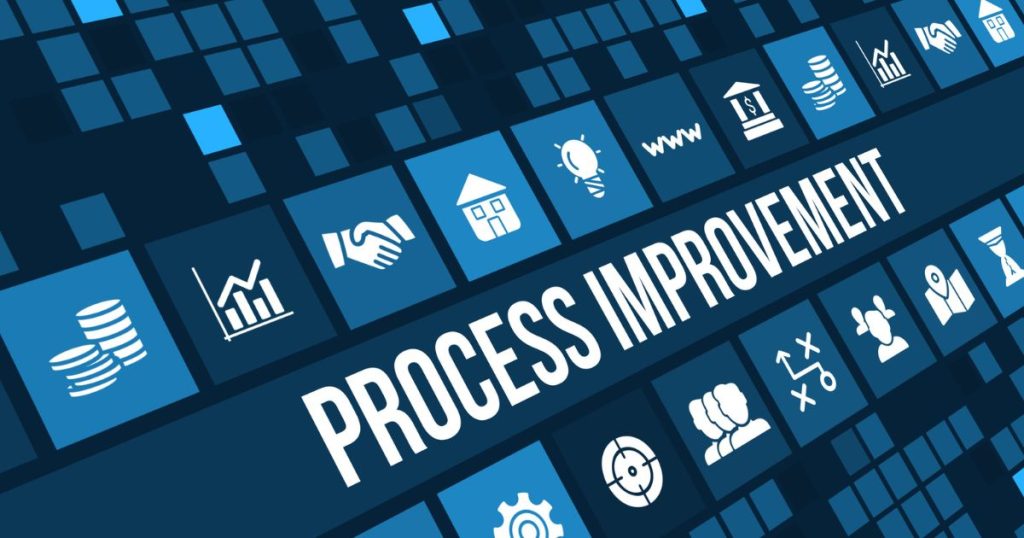The methodical process of improving an organization’s procedures to produce more effective results is known as process improvement. Process improvement in business refers to the examination of existing procedures, the identification of potential spots for improvement, and the implementation of modifications that result in activities that prove more successful and profitable. This article will describe process improvement, go over its aims and objectives, cover different approaches, and look at the advantages and difficulties that come with it.
Definition of Process Improvement
The process of examining corporate procedures and finding areas for enhancement in order to boost productivity, effectiveness, and flexibility is known as process improvement. This often entails using software to automate processes, improve quality, eliminate wasted efforts, and optimize operations. The objective is to maximize a company’s operational efficiency by making sure that procedures meet both client demands and organizational objectives.
Objectives and Goals of Process Improvement
The following are the precise aims and objectives of process improvement:
1. Reduce the amount of time and resources needed to do activities.
2. Enhance output quality and make sure that procedures get the intended outcomes.
3. Improve client satisfaction via the provision of superior goods or services.
4. Assess the best use of available resources to reduce operating expenses.
5. Ensure that procedures reduce risks and adhere to regulations.
6. Improve workers’ fulfillment with their jobs and working conditions.
How Do Business Process Improvements Work?
Process improvement frequently employs a number of approaches, each with its own methodology and set of tools. Several of the most popular approaches are as follows:
Six Sigma: Reduces process variability and finds and eliminates fault sources in order to enhance quality. It makes use of structured DMAIC (Define, Measure, Analyze, Improve, Control) methodology and statistical techniques.
Business process reengineering aims to increase productivity and performance by completely reimagining processes significantly.
Total Quality Management is an all-encompassing strategy that leverages customer happiness to drive long-term success. Under a methodical framework, TQM combines basic management practices, ongoing improvement initiatives, and technology tools.
Lean: Concentrates on cutting waste and enhancing workflow. Lean concepts prioritize the customer’s view of value and aim to get rid of everything that doesn’t improve things.
Agile: Originally designed for software development, Agile encourages flexibility to adapt to evolving needs and incremental improvements.
Kaizen: The word “kaizen” means “consistent enhancement.” It engages every employee, from the CEO to the workers on the assembly line, and promotes a continuous improvement culture.
Advantages of Process Improvement in Business
There are several advantages to implementing process improvements, including:
- Competitive Advantage: Organizations that consistently enhance their procedures may adapt to shifting market conditions and client demands with more efficiency, giving them a competitive advantage over rivals.
- Enhanced Efficiency: Streamlined procedures expedite completion times by cutting out pointless stages and delays.
- Cost Savings: Process optimization improves the bottom line by cutting waste and operating expenses.
- Better Quality: Better processes provide outputs with fewer faults and greater quality, which increases customer satisfaction.
- Increased Morale among Staff: Taking part in process improvement projects may boost staff morale and promote an atmosphere of continuous enhancement.
- Improved Compliance: Processes that are regulated and streamlined guarantee that legal requirements are followed, which lowers the possibility of non-compliance.
Obstacles to Business Process Improvement
- Due to Cultural Barriers: Initiatives for process improvement may not be successful if there is a culture that does not value continual improvement.
- Opposition to Change: Managers and staff may be resistant to changes because they are at ease with the current situation, fear something is amiss, or believe that changes would jeopardize their job security.
- Complexity: It might be challenging to find and apply changes for certain procedures without interfering with business operations due to their innate complexity.
- Measurement Challenges: It may be difficult to measure the advantages of process changes, especially when it comes to intangible results like staff morale or customer happiness.
- Sustainability: It takes constant work and dedication to sustain the improvements made via process improvement, and these qualities might fade with time.
- Lack of Resources: Funds, time, and skill are necessary for effective process improvement, yet these resources may be scarce.
What are the Stages in Process Improvement?
Process improvement phases often adhere to a defined approach, which is frequently shown by various models. Here are the stages of process improvement:

Determine Areas in Need of Improvement:
- Analysis and Examination: Use a variety of techniques, including comparison with norms in the industry, employee input, feedback from consumers, and performance indicators, to discover issues that need improvement.
- Specify your goals: Set quantifiable, unambiguous goals that correspond with corporate objectives.
Describe the Procedure: - Process Mapping: To comprehend workflows, spot delays, and see places for improvement, make intricate maps or diagrams of the present processes. Compile both numerical and descriptive data on the functioning of the process as it is.
- Key Performance Indicators (KPIs): Determine and set KPIs to track advancements and gauge performance.
Root Cause Analysis:
To find the core reasons of delays or issues, use methods like the Five Whys, Pareto Analysis, or Fishbone Diagrams (Ishikawa).
Gap analysis: To find gaps, compare actual performance to intended performance.
Create and Put into Action Solutions:
Idea generation and brainstorming: Come up with possible fixes and enhancements, often working with teams from multiple departments to bring in a variety of viewpoints.
Setting priorities:
Assess and rank potential solutions according to their effect, cost, time, and capability.
- Pilot Testing: Before implementing solutions widely, assess their efficacy on a smaller scale.
- Implementation: Provide appropriate communication and instruction while implementing the solutions across the whole company.
- Monitoring: Using the defined KPIs, keep an ongoing eye on the performance of the process.
Assess and Normative:
- Evaluation: Determine how well the adjustments that have been made have worked. Make that the goals and KPIs are fulfilled.
- Standardization: To guarantee stability and long-term viability, document the enhanced processes and incorporate them into established procedures for operations.
Constant Enhancement:
- Feedback Loop: To guarantee continuing improvements, create a continuous feedback loop. Promote a culture of ongoing development so that staff members are inspired to spot and seize chances for more improvements.
- Frequent Review: Plan on doing regular evaluations of procedures to make sure they continue to be effective and productive in changing corporate settings.
Conclusion
In summary, for companies looking to increase customer happiness, save expenses, and streamline operations, process improvement is a critical strategy. Organizations may successfully execute process changes by clearly establishing goals and objectives, choosing suitable approaches, and comprehending the advantages and difficulties. The benefits of enhanced productivity, superior quality, and competitive advantage make the trip worthwhile even if it might be difficult at times. Incorporating continuous improvement into the company culture is crucial for sustaining long-term success and flexibility in a constantly changing business landscape.





